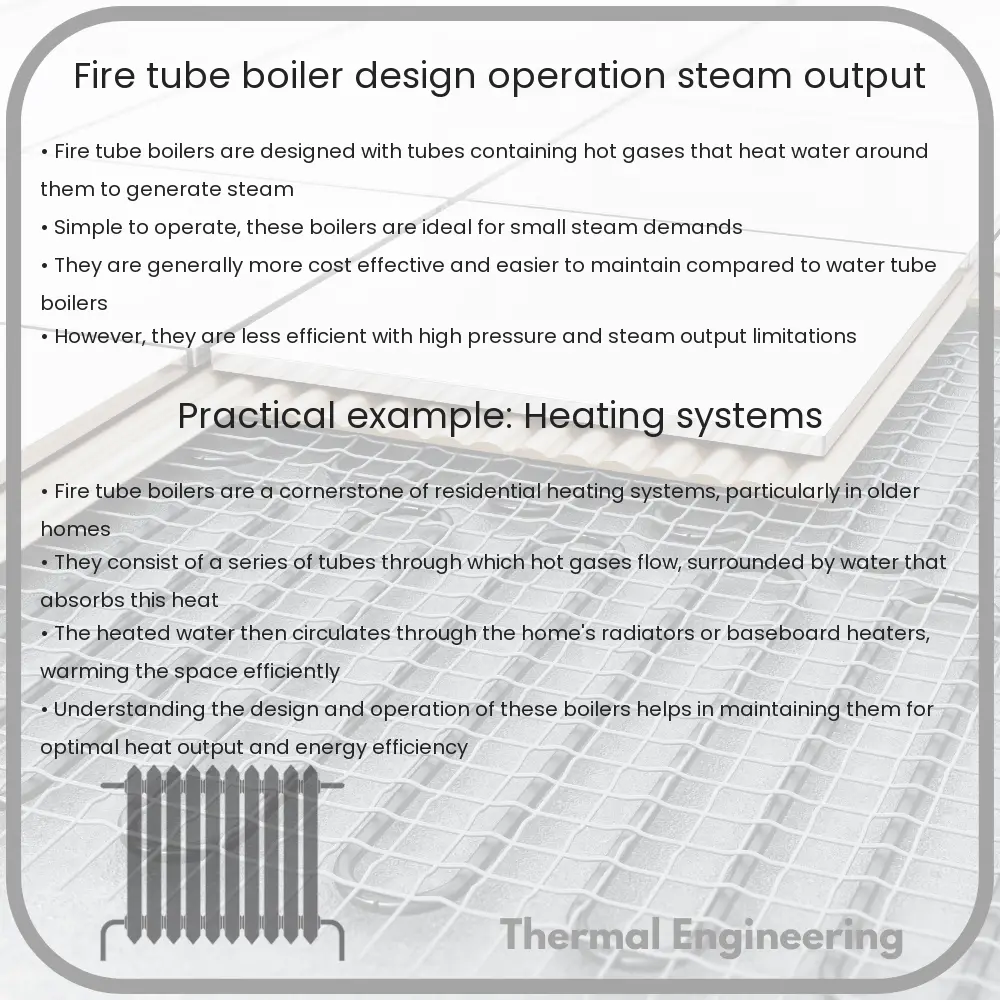Learn about fire tube boilers, their design, operation, and efficiency for steam generation in various applications.

Introduction to Fire Tube Boilers
A fire tube boiler is a type of boiler in which hot gases pass from a fire through one or more tubes running through a sealed container of water. The heat from the gases is transferred through the walls of the tubes by thermal conduction, heating the water and ultimately creating steam. This boiler design is one of the three main types used for generating steam in various applications, including building heating, power generation, and sanitation.
Design of Fire Tube Boilers
The fundamental design of a fire tube boiler includes a cylindrical shell with fire tubes running through it, enclosing the water space. The boiler has several key components:
- Shell: This is the external cylindrical part of the boiler that holds the water and the steam, made robust to withstand the boiler’s working pressure.
- Fire tubes: These are the tubes through which the hot flue gases travel. The heat from the combustion gases is transferred to the water through these tubes.
- Firebox: The area where the fuel is combusted, generating hot gas.
- Chimney/Stack: A channel through which the combusted exhaust gases are expelled into the atmosphere.
- Safety Valve: This is crucial for preventing pressure exceeding the design limits of the boiler.
- Water Feed: Used to supply water continuously and automatically to the boiler.
Fire tube boilers may further be classified into various types, such as the simple vertical boiler, Cochran boiler, Lancashire boiler, and Locomotive boiler, each varying in layout and efficiency.
Operation of Fire Tube Boilers
The operation of a fire tube boiler follows a standard sequence wherein fuel is burned in the firebox, producing hot gases that pass through the fire tubes. The following steps outline the operation:
- Fuel and air are introduced into the firebox and are ignited. This combustion process generates hot gases.
- These hot gases flow through the fire tubes. The fire tubes are submerged in water, allowing heat to transfer from the gases to the water.
- As the water heats up, it generates steam. The heat energy is thereby converted into thermal energy within the water.
- The steam accumulates at the top of the boiler and is extracted for use. The pressure within the boiler is maintained carefully to ensure safe operation.
- Exhaust gases are finally released into the environment through the chimney or stack.
The control and safety systems maintain the operation within the specified parameters, ensuring efficiency and safety. Common mechanisms include water level indicators, pressure gauges, and safety valves.
Steam Output and Efficiency
The steam output of fire tube boilers is influenced by the design, operation, and maintenance of the boiler. Although typically not as high-pressure capable as water tube boilers, fire tube boilers can still produce high temperatures and reasonable steam outputs. The steam generation process involves several factors:
- Boiler Size and Design: Larger boilers have larger surface areas for heat transfer but are also subject to greater heat losses.
- Fuel Type and Combustion Efficiency: Different fuels and combustion efficiencies can affect how effectively heat is transferred in the boiler.
- Water Quality: Impurities in water can lead to scaling on tube walls which reduces heat transfer efficiency.
Overall, the efficiency of fire tube boilers generally ranges from about 70% to 90%, depending on various factors such as boiler design, operating conditions, and maintenance practices.
Conclusion
Fire tube boilers are a proven technology for producing steam efficiently and safely. With their simplicity in design and operation, they continue to be widespread in various industrial and residential applications. Understanding the basics of fire tube boiler operation helps in optimizing the performance and preventive maintenance, leading to longer service life and economic operation.